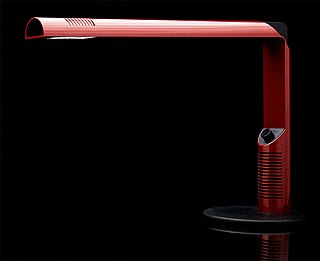Alessi is a housewares and kitchen utensil company in Italy, manufacturing and marketing everyday items authored by a wide range of designers, architects, and industrial designers — including Achille Castiglioni, Richard Sapper, Alessandro Mendini, Ettore Sottsass, Wiel Arets, Zaha Hadid, Toyo Ito, Tom Kovac, Greg Lynn, MVRDV, Jean Nouvel, UN Studio, Michael Graves, and Philippe Starck.

The Sacco chair, also called a bean bag chair,beanbag chair, or simply a beanbag, is a large fabric bag, filled with polystyrene beans, designed by Piero Gatti, Cesare Paolini and Franco Teodoro. The product is an example of an anatomic chair, as the shape of the object is set by the user. Sacco was awarded the XXVI Premio Compasso d'Oro and is exhibited in the permanent collection of the most important contemporary art museums throughout the world.

Compasso d'Oro is the name of an industrial design award originated in Italy in 1954 by the La Rinascente company from an original idea of Gio Ponti and Alberto Rosselli. From 1964 it has been hosted exclusively by Associazione per il Disegno Industriale (ADI). It is the first, and among the most recognized, awards in its field. The prize aims to acknowledge and promote quality in the field of industrial designs made in Italy and is awarded by ADI.

Alessandro Mendini was an Italian designer and architect. He played an important part in the development of Italian, Postmodern, and Radical design. He also worked, aside from his artistic career, for Casabella, Modo and Domus magazines.
Toshiyuki Kita is a furniture and product designer. He was born in 1942, in Osaka, Japan. Professor at the Osaka University of Arts. His earliest pieces, the Wink Chair and the Kick Table are currently in the permanent collections of the New York City Museum of Modern Art and Hamburg, Germany's Museum fur Kunst und Gewerbe.

Achille Castiglioni was an Italian architect and designer of furniture, lighting, radiograms and other objects. As a professor of design, he advised his students "If you are not curious, forget it. If you are not interested in others, what they do and how they act, then being a designer is not the right job for you."

Alberto Meda is an engineer focusing on design, born in Tremezzina, in the Italian province of Como in 1945. He graduated with a laurea in mechanical engineering at the Politecnico di Milano in 1969. From 1973 he was the technical manager of Kartell, in charge of the development of projects of furniture and plastic laboratory equipment.

Angelo Mangiarotti was an Italian architect and industrial designer. His designs were mostly for industrial buildings and railway stations. In 1994 he received the Compasso d'Oro award of the Associazione per il Disegno Industriale for his lifetime of achievement.

Giulio Cappellini is the founder and art director of the eponymous Italian furniture company Cappellini based in Milan. In 2004 the Company became part of the Poltrona Frau Group. In 2021, it was acquired by the American office furnisher Haworth Inc.

Gianfranco Frattini was an Italian architect and designer. He is a member of the generation that created the Italian design movement in the late 1950s through the 1960s and is considered to have played a major role in shaping it.

Lodovico Migliore, nicknamed Ico, is an Italian architect, designer, professor and former professional ice hockey player. He is professor at the School of Design of the Polytechnic University of Milan and he is Chair Professor of the College of Design at Busan Dongseo University in South Korea. He served as chairman of Hockey Milano Rossoblu, an ice hockey team in Elite.A based out of Milan, Italy from 2010 to 2016. He also competed in the men's tournament at the 1984 Winter Olympics.
Margherita Servetto, better known as Mara, is an Italian architect and designer.

Pier Giacomo Castiglioni was an Italian architect and designer.
Michele de Lucchi is an Italian architect and designer.

Konstantin Grcic, born 1965, is a German industrial designer known for creating mass-manufactured items, such as furniture and household products. He has participated in leading design shows and his work can be seen in major museums. Described as having a pared down aesthetic, his functional designs are characterized by geometric shapes and unexpected angles.
Studio Alchimia was a post-radical avant-garde group founded in Milan in 1976 by Alessandro Guerriero and his sister Adriana with the stated mission of "materializing a non-existent thing into being."

Jonathan Olivares is an American industrial designer and author. Olivares's approach to design has been characterized research-based and incremental. In April 2022 he became Senior Vice-President of Design at the Knoll furniture company.

Livio Castiglioni was an Italian architect and designer. He made a significant contribution to twentieth-century Italian lighting design and was an early proponent of the practice of industrial design in Italy.

















